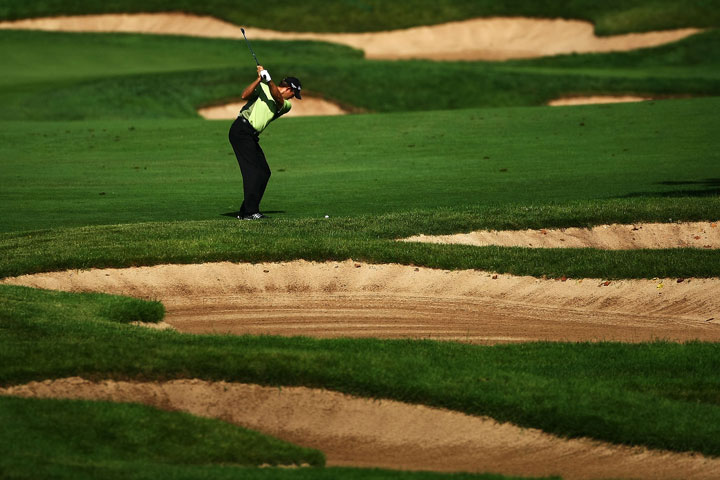Glen Abbey Golf Club, which will host this week’s RBC Canadian Open, began as the vision of a man who couldn’t see.

In 1972, Rod McIsaac, a developer who had an interest in golf, went to see the Canadian Open, which was being held that year at Cherry Hill Golf and Country Club.
A course located at near the Niagara Escarpment in Ridgeway, Ont., Cherry Hill featured designer Walter Travis’ typical classic features and a fine set of greens. However, Travis, a former U.S. and British Amateur champion who created the Cherry Hill in 1922, never considered whether the course would be appropriate for the throngs of spectators who roamed all over during the ’72 Open. Simply put, McIsaac, a man who was large in ambition, but small in stature, couldn’t see over thousands of other fans to get a glimpse of Gary Player as he walked to the fourth tee, let alone witness Gay Brewer’s victory.
He complained to others at the tournament about his inability to view what was going on.
“A lady at a reception suggested maybe I should do something about it,” he said at the time.
Two years later, McIsaac followed the woman’s advice, purchasing the Upper Canada Country Club, located in Oakville, Ont., and land surrounding the golf club. He joined with the the RCGA (now Golf Canada) in hiring superstar Jack Nicklaus to build a golf course that would test the best the PGA Tour had to offer, while allowing spectators to take in all the highs and lows of a Canadian Open. It was Nicklaus’ first solo design, opening two years after he developed Muirfield Village in Ohio with Desmond Muirhead.
The course is now nearing its 40th anniversary and throughout that period it has become the regular home of the RBC Canadian Open.

Once the site of a 350-acre estate, the area had been home to the Jesuit Fathers of Upper Canada for which the course’s “swinging abbey,” logo is based. The property had been owned by mining magnate Andre Dorfman and was sold in 1952 to the Society of Jesuits. However, the Jesuits who apparently never fond of the location, sold the property in 1962 and moved to Guelph. The land was purchased by Clearstream Developments Ltd., which intended to convert the Jesuit residence and Dorfman’s estate home into a country club.
The company also built a golf course, called Upper Canada Country Club and designed by Howard Watson. The course opened in 1965, though the country club project was never entirely successful.
Glen Abbey was the dream of McIsaac and Dick Grim, then chairman of the Canadian Open and soon to be president of the Royal Canadian Golf Association. The pair wanted to build a course that could be home to the Canadian Open and that would allow spectators to view the increasingly popular sport. The pair focused their sites on Oakville’s upstart country club with the intent to purchase the land. McIsaac and his company, Great Northern Capital Corp., would reap the benefits from the site’s real estate potential, while the RCGA would have a permanent home and a course to house its most prestigious tournament.
While the existing Watson-designed course used parts of the flatland and the valley along 16 Mile Creek and was 6,850 yards long, it was deemed to not be up to standard needed to host the Canadian Open.
Given the interest in selling real estate on the edges of the golf course, it is not surprising that McIsaac went looking for a name to make his project more marketable.
McIsaac surprised some when he chose Nicklaus, a superstar on the course, but still a relative neophyte when it came to golf course design. However, Nicklaus had worked alongside fabled architect Pete Dye on several projects, including Harbor Town in South Carolina and partnered with quirky designer Desmond Muirhead on several clubs, including Muirfield Village in Dublin, Ohio, which became the blueprint for the so-called “stadium” golf course. However, the project that would become known as Glen Abbey was Nicklaus’ first design that would feature his name without and assistance from another architect.
“I think I learned things from both Pete and Desmond, but the reason I went off on my own was that I wanted to use my own ideas and not somebody else’s,” Nicklaus said.
“Glen Abbey was the first golf course that I believe was done with the spectator in mind. We did a wheel spoke design, where you had a central gallery, a halfway-out gallery and a following gallery where everybody could have a variety of ways to view the golf. It’s an idea that I came up with and it seemed to work.”

Construction costs were pegged at $2 million, a large price for a course built over two years starting in 1974. Even though he’s developed more than 200 courses since creating Glen Abbey, Nicklaus recalled many of the hurdles that faced his solo design. There were significant environmental issues surrounding 16 Mile Creek and the construction crew had to be certain water could flow freely through the holes that would become the middle of the final nine.
Nicklaus recalled: “You had a lot of issues in the valley that were environmental in nature, whether water issues or flood plain issues. We just tried to bring the golf into that and we decided going up the valley was the best way to play the valley.”
That decision led to what many consider one of the finest stretches of holes in Canadian golf. From the 11th, with its dramatic drop and approach shot over 16 Mile Creek, through to the short, but tricky par three 15th, Nicklaus created golf holes that still challenge the best in the world.
Though the course was not ready for the 1976 Canadian Open as planned, Nicklaus and the public seemed very pleased with the result.
“It is the best gallery course in the world,” he said after doing a course tour in 1976. The course would be purchased by the RCGA in 1981 for $3 million.
At the time Nicklaus designed the Abbey he was quoted as saying the course expressed his belief that “golf is basically a game of precision, not power.”
The course was sold to ClubLink Corp. in 1998 for a reported $40 million.
Today’s Abbey is essentially the same course Nicklaus created. There has been discussion of renovating the course, changing some of its unusual features, like the peculiar 17th green and altering features to determine, once and for all, whether the 16th should play as a par five or par four.
Has Glen Abbey become a relic of the past, a course that can no longer contain the likes of the game’s biggest hitters, names like Bubba Watson or JB Holmes? Nicklaus said that is somewhat true.
“Glen Abbey, yes, as has every other course in the world,” said Nicklaus, who has argued in favour of limiting the flight of balls used in tournament play.
While Toronto’s St. George’s Golf and Country Club or the remote Cabot Links in Cape Breton may eclipse Glen Abbey in the minds of critics, no other course can claim to have been witness to so many great moments in Canadian golf.
The dramatic finishing hole, protected by a large pond in front of the green, became iconic when Tiger Woods hit a 218-yard six iron out of a bunker on the right of the fairway to claim the 2000 Canadian Open title in a duel with Grant Waite.
While the likes of Woods, Greg Norman and Lee Trevino have won at the Abbey, Nicklaus never pulled off a victory at the course he designed. The course never yielded a Canadian Open victory, but Nicklaus still thinks of fondly of his first solo attempt.
“It is my first solo design, and it is a pretty good golf course,” he said at the time of the Canadian Open’s centenary. “I don’t think it is the most difficult golf course in the world, but I certainly don’t think it is the easiest golf course. I think it has served its purpose very well for the Canadian Open. It’s been very popular over the years.”



Comments